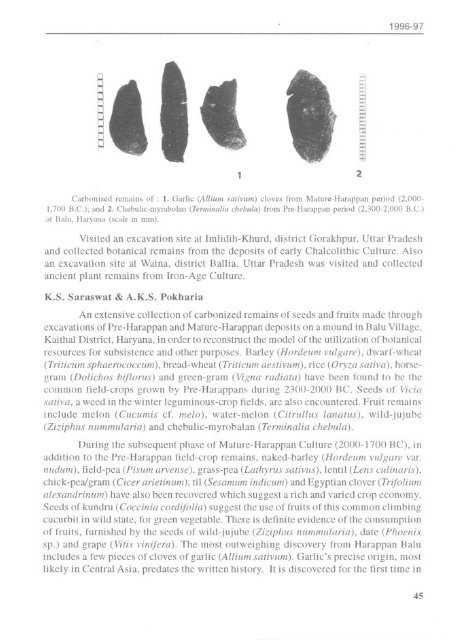1996-97 - Birbal Sahni Institute of Palaeobotany
1996-97 - Birbal Sahni Institute of Palaeobotany
1996-97 - Birbal Sahni Institute of Palaeobotany
Create successful ePaper yourself
Turn your PDF publications into a flip-book with our unique Google optimized e-Paper software.
<strong>1996</strong>-<strong>97</strong><br />
- c:<br />
!<br />
0<br />
2<br />
1<br />
-<br />
Carhonised remains <strong>of</strong> : I. Garlic (Allium sativum) cloves from Mature-liarappan period (2.000<br />
1.700 B.C.); and 2. Chebulic-mymbolan (Terl1linlllia chebula) from Pre-Ilarappan period (2.300-2,000 B.C.)<br />
al Halu. lIaryana (scClle in mm).<br />
Visited an excavation site at Imlidih-Khurd, district Gorakhpur, Uttar Pradesh<br />
and collected botanical remains from the deposits <strong>of</strong> early Chalcolithic Culture. Also<br />
an excavation site at Waina, district Ballia, Uttar Pradesh was visited and collected<br />
ancient plant remains from Iron-Age Culture.<br />
K.S. Saraswat<br />
& A.K.S. Pokharia<br />
An extensive collection <strong>of</strong> carbonized remai ns <strong>of</strong> seedsand fruits made tIu'ough<br />
excavations <strong>of</strong> Pre-Harappan and Mature-Harappan deposits on a mound in Balu Village,<br />
Kaithal District, Haryana, in order to reconstruct the model <strong>of</strong> the utilization <strong>of</strong> botanical<br />
resources for subsistence and other purposes. Barley (Hordeum vulgare), dwarf-wheat<br />
(Triticum sphaerococcum), bread-wheat (Triticum aestivum), rice (Oryza sativa), horsegram<br />
(Do/ichos biJlorus) and green-gram (Viglla radiata) have been found to be the<br />
common field-crops grown by Pre-Harappans during 2300-2000 Be. Seeds <strong>of</strong> Vida<br />
sativa, a weed in the winter leguminous-crop fields, arc also encountered. Fruit remains<br />
include melon (Cuculllis cf. melo), water-melon (Citrul/us lanatus), Wild-jujube<br />
(Ziziphus Ilummularia) and ehebulic-myrobalan (Terminalia chebula).<br />
During the subsequelll phase <strong>of</strong> Mature-Harappan Culture (2000-1700 BC), in<br />
addition to the Pre-Harappan field-crop remains, naked-barley (Hordeulll vulgare val'.<br />
nl/dum), field-pea (Pisul/l arvense), grass-pea(Lathyrus salivus), lentil (Lens cu/illaris),<br />
chick-pea/gram (Cicer arietillum), til (Sesamulll indicllln) and Egyptian clover (Trifolium<br />
alexandril1l/m) have also been recovered which suggest a rich and varied crop economy.<br />
Seeds<strong>of</strong> kundru (Coccinia cordijolia) suggest the use<strong>of</strong> fruits <strong>of</strong> Ihis common climbing<br />
cucurbit in wild state, for green vegetable. There is definite evidence <strong>of</strong>lhe consumption<br />
<strong>of</strong> fruits, furnished by the seeds <strong>of</strong> wild-jujube (Ziziphus Ill/mmu/aria), date (Phoenix<br />
sp.) and grape (Vitis villijera). The most outweighing discovery from Harappan Balu<br />
i ncl udes a few pieces <strong>of</strong> cloves <strong>of</strong> garlic (AI/iulll sativum). Garlic's precise origin, most<br />
likely in Central Asia, predates the written history. It is discovered for the first time in<br />
45

















